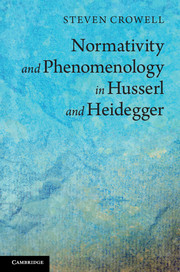Book contents
- Frontmatter
- Contents
- Acknowledgments
- Citation conventions for the works of Husserl and Heidegger
- Introduction
- Part I Transcendental philosophy, phenomenology, and normativity
- Part II Husserl on consciousness and intentionality
- 4 The first-person character of philosophical knowledge
- 5 Phenomenological immanence, normativity, and semantic externalism
- 6 The normative in perception
- 7 Husserl’s subjectivism and the philosophy of mind
- Part III Heidegger, care, and reason
- Part IV Phenomenology and practical philosophy
- References
- Index
6 - The normative in perception
Published online by Cambridge University Press: 05 April 2013
- Frontmatter
- Contents
- Acknowledgments
- Citation conventions for the works of Husserl and Heidegger
- Introduction
- Part I Transcendental philosophy, phenomenology, and normativity
- Part II Husserl on consciousness and intentionality
- 4 The first-person character of philosophical knowledge
- 5 Phenomenological immanence, normativity, and semantic externalism
- 6 The normative in perception
- 7 Husserl’s subjectivism and the philosophy of mind
- Part III Heidegger, care, and reason
- Part IV Phenomenology and practical philosophy
- References
- Index
Summary
Perception as epistemic warrant
Suppose I tell a friend that the rose bush on my front porch is in bloom. If he wonders how I know such a thing, I might respond that I saw it as I left for work this morning. If pressed, I might invite my friend home so he can see the bush for himself. What is supposed to be served by my report of what I saw? It is supposed to provide justification for what I say by grounding it in what I see. But what does “grounding” mean here? My claim about the rose bush is a claim about an entity in the world, and I assume that looking at such an entity warrants the claim, that perceiving it underwrites the truth of what I say. Skeptics have often questioned this assumption, pointing out that perception can be deceptive in many ways; indeed we may have no good reason for holding that any perception delivers the world as it is. When I make a judgment, the object about which I judge becomes a standard against which the judgment may be measured: if the object is as I say it is, then my judgment is true (i.e., does what it is supposed to do as this judgment); if not, not. But the skeptic reminds us that the fact that the object is a norm for judgment does not entail that perception can serve as warrant for judgments. Only if perception provides reliable access to objects can it serve this role. To show that it does, one might try to establish a connection between the content of perception and a causal process running from the object to the brain. But this has the disadvantage of severing ties between justification and the first-person experience of getting it right. Whether this is a price we are willing to pay for an answer to the skeptic is something that others will have to decide. The sort of approach that interests me here, a phenomenological one, looks for the connection between perception and epistemic warrant in first-person experience.
Information
- Type
- Chapter
- Information
- Normativity and Phenomenology in Husserl and Heidegger , pp. 124 - 146Publisher: Cambridge University PressPrint publication year: 2013
Accessibility standard: Unknown
Why this information is here
This section outlines the accessibility features of this content - including support for screen readers, full keyboard navigation and high-contrast display options. This may not be relevant for you.Accessibility Information
- 1
- Cited by
